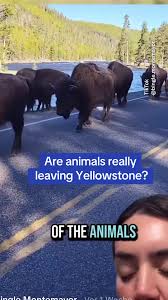The Phenomenon of Animals Leaving Yellowstone National Park

Introduction
The migration patterns of animals within Yellowstone National Park have always captivated researchers, conservationists, and nature enthusiasts alike. However, a concerning trend has emerged in recent months: a notable number of species are leaving their traditional habitats within the park. This shift is not just a matter of animal behavior; it raises significant questions about environmental changes, climate influences, and the park’s overall ecological health.
What’s Happening?
Recent observations reveal that various species, including elk, bison, and wolves, are abandoning their typical ranges within the park’s borders. These changes have been documented through satellite tracking and direct observation, leading wildlife biologists to investigate the underlying causes. Factors such as increasing temperatures, availability of food sources, and changes in human activity in the surrounding areas are believed to play crucial roles in this phenomenon.
The Role of Climate Change
Climate change has emerged as a significant contributing factor. With rising temperatures leading to early springs and hotter summers, food availability shifts dramatically. For instance, grass and forage growth may no longer align perfectly with animal breeding cycles, forcing species to seek resources elsewhere. Furthermore, altered weather patterns have resulted in reduced precipitation, impacting the overall health of the ecosystem.
Implications for Ecosystems
The exodus of animals from Yellowstone is alarming for several reasons. Firstly, it disrupts the delicate balance of predator and prey dynamics. For example, if elk migrate out of the park, wolves may find themselves with fewer available food sources, which could lead to declines in their population. Secondly, these changes affect the broader ecosystem, including plant life and soil health, ultimately impacting the entire habitat.
Conservation Efforts in the Works
In response to these developments, the Yellowstone National Park Management is actively collaborating with wildlife biologists and ecologists to monitor animal movements and assess their health. Ongoing research aims to identify the specific triggers for the movement of these species and to develop strategic conservation initiatives. Campers and visitors are also being urged to reduce their impact on wildlife by respecting designated areas and minimizing human interference during critical migratory periods.
Conclusion
The continuing trend of animals leaving Yellowstone National Park underscores the urgency of addressing climate change and its far-reaching effects on wildlife. As researchers work to understand this behavior, it highlights the importance of sustainable practices and conservation efforts. For outdoor enthusiasts and wildlife advocates, staying informed about these changes is crucial in supporting initiatives that aim to protect Yellowstone’s diverse ecosystems for future generations.









